Junctionless Transistors: State-of-the-Art
Abstract
:1. Introduction
2. Classification
3. Analysis
3.1. The First Junctionless Transistor
3.2. Gate-All-Around
3.3. FinFET
3.4. Single Gate
3.5. Double Gate
3.6. Thin Film
3.7. Tunnel FET
4. Conclusions
Author Contributions
Funding
Conflicts of Interest
Abbreviations
| AM | Accumulation Mode |
| BJT | Bipolar Junction Transistor |
| BTBT | Band-To-Band Tunneling |
| BOX | Buried Oxide |
| DG | Double Gate |
| DIBL | Drain-Induced Barrier Lowering |
| FET | Field Effect Transistor |
| GAA | Gate-All-Around |
| IM | Inversion Mode |
| JLT | Junctionless Transistor |
| JT | Junction Transistor |
| LFN | Low Frequency Noise |
| NW | Nanowire |
| SELBOX | Selective Buried Oxide |
| SG | Single Gate |
| SNR | Signal-To-Noise Ratio |
| SOI | Silicon-On-Insulator |
| SON | Silicon-On-Nothing |
| SS | Subthreshold Swing |
| TFET | Tunnel Field Effect Transistor |
| TFT | Thin Film Transistor |
| TG | Triple Gate |
References
- Lilienfeld, J. Method and Apparatus for Controlling Electric Currents. U.S. Patent 1,745,175, 28 January 1930. [Google Scholar]
- Colinge, J.P.; Lee, C.W.; Afzalian, A.; Akhavan, N.D.; Yan, R.; Ferain, I.; Razavi, P.; O’neill, B.; Blake, A.; White, M.; et al. Nanowire transistors without junctions. Nat. Nanotechnol. 2010, 5, 225. [Google Scholar] [CrossRef] [PubMed]
- Rios, R.; Cappellani, A.; Armstrong, M.; Budrevich, A.; Gomez, H.; Pai, R.; Rahhal-Orabi, N.; Kuhn, K. Comparison of junctionless and conventional trigate transistors with Lg down to 26 nm. IEEE Electron. Device Lett. 2011, 32, 1170–1172. [Google Scholar] [CrossRef]
- Han, M.H.; Chang, C.Y.; Chen, H.B.; Cheng, Y.C.; Wu, Y.C. Device and circuit performance estimation of junctionless bulk FinFETs. IEEE Trans. Electron. Devices 2013, 60, 1807–1813. [Google Scholar] [CrossRef]
- Priya, A.; Rai, S.; Mishra, R.A. Comparative analysis of junctionless bulk and SOI/SON FinFET. In Proceedings of the 2017 4th International Conference on Power, Control & Embedded Systems (ICPCES), Allahabad, India, 9–11 March 2017; pp. 1–4. [Google Scholar]
- Han, M.H.; Chang, C.Y.; Chen, H.B.; Wu, J.J.; Cheng, Y.C.; Wu, Y.C. Performance comparison between bulk and SOI junctionless transistors. IEEE Electron. Device Lett. 2013, 34, 169–171. [Google Scholar] [CrossRef] [Green Version]
- Bharathi, R.; Durga, G.; Kumar, N.V.; Nagarajan, K.; Srinivasan, R. Performance optimization of bulk junctionless FinFETs through work function engineering. In Proceedings of the 2014 International Conference on Circuits, Power and Computing Technologies [ICCPCT-2014], Nagercoil, India, 20–21 March 2014; pp. 1291–1295. [Google Scholar]
- Bousari, N.B.; Anvarifard, M.K.; Haji-Nasiri, S. Improving the Electrical Characteristics of Nanoscale Triple-Gate Junctionless FinFET Using Gate Oxide Engineering. AEU Int. J. Electron. Commun. 2019, 108, 226–234. [Google Scholar] [CrossRef]
- Saini, G.; Choudhary, S. Improving the subthreshold performance of junctionless transistor using spacer engineering. Microelectron. J. 2017, 59, 55–58. [Google Scholar] [CrossRef]
- Kaundal, S.; Rana, A.K. Design and structural optimization of junctionless FinFET with Gaussian-doped channel. J. Comput. Electron. 2018, 17, 637–645. [Google Scholar] [CrossRef]
- Pal, P.K.; Nehra, D.; Kaushik, B.K.; Dasgupta, S. Enhanced device performance using lightly doped channel junctionless accumulation-mode FinFET. In Proceedings of the 2015 12th International Conference on Electrical Engineering/Electronics, Computer, Telecommunications and Information Technology (ECTI-CON), Hua Hin, Thailand, 24–27 June 2015; pp. 1–5. [Google Scholar]
- Bharti, S.; Saini, G. Sensitivity Analysis of Junctionless FinFET for Analog Applications. In Proceedings of the 2018 Second International Conference on Intelligent Computing and Control Systems (ICICCS), Madurai, India, 14–15 June 2018; pp. 1288–1293. [Google Scholar]
- Kaundal, S.; Rana, A.K. Threshold voltage modeling for a Gaussian-doped junctionless FinFET. J. Comput. Electron. 2019, 18, 83–90. [Google Scholar] [CrossRef]
- Tayal, S.; Nandi, A. Analog/RF performance analysis of channel engineered high-k gate-stack based junctionless trigate-FinFET. Superlattices Microstruct. 2017, 112, 287–295. [Google Scholar] [CrossRef]
- Lü, W.F.; Dai, L. Impact of work-function variation on analog figures-of-merits for high-k/metal-gate junctionless FinFET and gate-all-around nanowire MOSFET. Microelectron. J. 2019, 84, 54–58. [Google Scholar] [CrossRef]
- Dwivedi, S.; Saini, G. Effect of random dopant fluctuation in nanoscale junctionless FinFET using low and high-k spacers. In Proceedings of the 2017 8th International Conference on Computing, Communication and Networking Technologies (ICCCNT), Delhi, India, 3–5 July 2017; pp. 1–4. [Google Scholar]
- Nawaz, S.M.; Dutta, S.; Chattopadhyay, A.; Mallik, A. Comparison of random dopant and gate-metal workfunction variability between junctionless and conventional FinFETs. IEEE Electron. Device Lett. 2014, 35, 663–665. [Google Scholar]
- Nawaz, S.M.; Mallik, A. Effects of device scaling on the performance of junctionless FinFETs due to gate-metal work function variability and random dopant fluctuations. IEEE Electron. Device Lett. 2016, 37, 958–961. [Google Scholar] [CrossRef]
- Jegadheesan, V.; Sivasankaran, K. RF stability performance of SOI junctionless FinFET and impact of process variation. Microelectron. J. 2017, 59, 15–21. [Google Scholar] [CrossRef]
- Liu, F.Y.; Liu, H.Z.; Liu, B.W.; Guo, Y.F. An analytical model for nanowire junctionless SOI FinFETs with considering three-dimensional coupling effect. Chin. Phys. B 2016, 25, 47305. [Google Scholar] [CrossRef]
- Kumar, A.; Chhabra, A.; Chaujar, R. GaAs Junctionless FinFET Using High-k Dielectric for High-Performance Applications. In Proceedings of the 2018 IEEE 38th International Conference on Electronics and Nanotechnology (ELNANO), Kiev, Ukraine, 24–26 April 2018; pp. 126–129. [Google Scholar]
- Lee, J.; Kim, Y.; Cho, S. Design of poly-Si junctionless fin-channel FET with quantum-mechanical drift-diffusion models for sub-10-nm technology nodes. IEEE Trans. Electron. Devices 2016, 63, 4610–4616. [Google Scholar] [CrossRef]
- Chang, P.C.; Hsiao, C.J.; Lumbantoruan, F.J.; Wu, C.H.; Lin, Y.K.; Lin, Y.C.; Sze, S.M.; Chang, E.Y. InGaAs Junctionless FinFETs With Self-Aligned Ni-InGaAs S/D. IEEE J. Electron. Devices Soc. 2018, 6, 856–860. [Google Scholar] [CrossRef]
- Djeffal, F.; Ferhati, H.; Bentrcia, T. Improved analog and RF performances of gate-all-around junctionless MOSFET with drain and source extensions. Superlattices Microstruct. 2016, 90, 132–140. [Google Scholar] [CrossRef]
- Moon, D.I.; Choi, S.J.; Duarte, J.P.; Choi, Y.K. Investigation of silicon nanowire gate-all-around junctionless transistors built on a bulk substrate. IEEE Trans. Electron. Devices 2013, 60, 1355–1360. [Google Scholar] [CrossRef]
- Sharma, M.; Gupta, M.; Narang, R.; Saxena, M. Investigation of Gate All Around Junctionless Nanowire Transistor with Arbitrary Polygonal Cross Section. In Proceedings of the 2018 4th International Conference on Devices, Circuits and Systems (ICDCS), Coimbatore, India, 16–17 March 2018; pp. 159–163. [Google Scholar]
- Nobrega, R.; Fonseca, Y.; A Costa, R.; Duarte, U. Comparative Study on the Performance of Silicon and III-V Nanowire Gate-All-Around Field-Effect Transistors for Different Gate Oxides. In Proceedings of the XIII Workshop on Semiconductors and Micro & Nano Technology, São Bernardo do Campo, Brazil, 19–20 April 2018. [Google Scholar]
- Singh, P.; Singh, N.; Miao, J.; Park, W.T.; Kwong, D.L. Gate-all-around junctionless nanowire MOSFET with improved low-frequency noise behavior. IEEE Electron. Device Lett. 2011, 32, 1752–1754. [Google Scholar] [CrossRef]
- Sharma, S. An Extensive Evaluation of Futuristic Gate All Around Junctionless Nanowire MOSFET Using Numerical Simulation. Int. J. Res. Appl. Sci. Eng. Technol. 2017, V, 1974–1979. [Google Scholar] [CrossRef]
- Han, M.H.; Chang, C.Y.; Jhan, Y.R.; Wu, J.J.; Chen, H.B.; Cheng, Y.C.; Wu, Y.C. Characteristic of p-type junctionless gate-all-around nanowire transistor and sensitivity analysis. IEEE Electron. Device Lett. 2013, 34, 157–159. [Google Scholar] [CrossRef]
- Lime, F.; Ávila-Herrera, F.; Cerdeira, A.; Iñiguez, B. A compact explicit DC model for short channel Gate-All-Around junctionless MOSFETs. Solid State Electron. 2017, 131, 24–29. [Google Scholar] [CrossRef]
- Ferhati, H.; Djeffal, F.; Bentrcia, T. Investigation of analog/RF performance of gate-all-around junctionless MOSFET including interfacial defects. In Proceedings of the 2015 4th International Conference on Electrical Engineering (ICEE), Boumerdes, Algeria, 13–15 December 2015; pp. 1–4. [Google Scholar]
- Liu, T.Y.; Pan, F.M.; Sheu, J.T. Characteristics of gate-all-around junctionless polysilicon nanowire transistors with twin 20-nm gates. IEEE J. Electron. Devices Soc. 2015, 3, 405–409. [Google Scholar] [CrossRef]
- Pratap, Y.; Gautam, R.; Haldar, S.; Gupta, R.; Gupta, M. Physics-based drain current modeling of gate-all-around junctionless nanowire twin-gate transistor (JN-TGT) for digital applications. J. Comput. Electron. 2016, 15, 492–501. [Google Scholar] [CrossRef]
- Kumar, P.; Singh, S.; Singh, N.P.; Modi, B.; Gupta, N. Germanium v/s silicon Gate-all-around junctionless nanowire transistor. In Proceedings of the 2014 2nd International Conference on Devices, Circuits and Systems (ICDCS), Combiatore, India, 6–8 March 2014; pp. 1–5. [Google Scholar]
- Sung, P.J.; Cho, T.C.; Chen, P.C.; Hou, F.J.; Lai, C.H.; Lee, Y.J.; Li, Y.; Samukawa, S.; Chao, T.S.; Wu, W.F.; et al. High performance silicon N-channel gate-all-around junctionless field effect transistors by strain technology. In Proceedings of the 2016 IEEE 16th International Conference on Nanotechnology (IEEE-NANO), Sendai, Japan, 22–25 August 2016; pp. 174–175. [Google Scholar]
- Arefín, U.A. Impact of Temperature on Threshold Voltage of Gate-All-Around Junctionless Nanowire Field-Effect Transistor. ULAB J. Sci. Eng. 2015, 6, 14–18. [Google Scholar]
- Gundapaneni, S.; Ganguly, S.; Kottantharayil, A. Bulk planar junctionless transistor (BPJLT): An attractive device alternative for scaling. IEEE Electron. Device Lett. 2011, 32, 261–263. [Google Scholar] [CrossRef]
- Baruah, R.K.; Paily, R.P. Analog performance of bulk planar junctionless transistor (BPJLT). In Proceedings of the 2012 Third International Conference on Computing, Communication and Networking Technologies (ICCCNT’12), Coimbatore, India, 26–28 July 2012; pp. 1–4. [Google Scholar]
- Baruah, R.K.; Paily, R.P. Impact of active well biasing on process-induced variations of a bulk planer junctionless transistor. In Proceedings of the 2016 3rd International Conference on Emerging Electronics (ICEE), Mumbai, India, 27–30 December 2016; pp. 1–4. [Google Scholar]
- Jenifer, I.; Vinodhkumar, N.; Srinivasan, R. Optimization of Bulk Planar Junctionless Transistor using Work function, Device layer thickness and Channel doping concentration with OFF Current constraint. In Proceedings of the 2016 Online International Conference on Green Engineering and Technologies (IC-GET), Coimbatore, India, 19 November 2016; pp. 1–3. [Google Scholar]
- Huda, A.; Arshad, M.M.; Othman, N.; Voon, C.; Ayub, R.; Gopinath, S.C.; Foo, K.; Ruslinda, A.; Hashim, U.; Lee, H.C.; et al. Impact of size variation in junctionless vs junction planar SOI n-MOSFET transistor. In Proceedings of the 2015 IEEE Regional Symposium on Micro and Nanoelectronics (RSM), Kuala Terengganu, Malaysia, 19–21 August 2015; pp. 1–4. [Google Scholar]
- Singh, D.K.; Kumar, P.K.; Akram, M. Investigation of Planar and Double-Gate Junctionless Transistors with Non-Uniform Doping. In Proceedings of the 2018 5th IEEE Uttar Pradesh Section International Conference on Electrical, Electronics and Computer Engineering (UPCON), Gorakhpur, India, 2–4 November 2018; pp. 1–5. [Google Scholar]
- Scarlet, S.P.; Srinivasan, R. Impact of Doping and Spacer on the Performance of Bulk Planar Junctionless devices. In Proceedings of the 2018 4th International Conference on Electrical Energy Systems (ICEES), Chennai, India, 7–9 February 2018; pp. 267–273. [Google Scholar]
- Gundapaneni, S.; Ganguly, S.; Kottantharayil, A. Enhanced Electrostatic Integrity of Short-Channel Junctionless Transistor With High-k Spacers. IEEE Electron. Device Lett. 2011, 32, 1325–1327. [Google Scholar] [CrossRef]
- Ramarao, G.; Ghosekar, I.C.; Patil, G.C. Dual-k HfO 2 Spacer Bulk Planar Junctionless Transistor for Sub-30 nm Low Power CMOS. In Proceedings of the 2017 14th IEEE India Council International Conference (INDICON), Roorkee, India, 15–17 December 2017; pp. 1–4. [Google Scholar]
- Parihar, M.S.; Liu, F.; Navarro, C.; Barraud, S.; Bawedin, M.; Ionica, I.; Kranti, A.; Cristoloveanu, S. Back-gate effects and mobility characterization in junctionless transistor. Solid State Electron. 2016, 125, 154–160. [Google Scholar] [CrossRef]
- Khan, U.; Ghosh, B.; Akram, M.W.; Salimath, A. A comparative study of SELBOX-JLT and SOI-JLT. Appl. Phys. A 2014, 117, 2281–2288. [Google Scholar] [CrossRef]
- Gundapaneni, S.; Bajaj, M.; Pandey, R.K.; Murali, K.V.; Ganguly, S.; Kottantharayil, A. Effect of band-to-band tunneling on junctionless transistors. IEEE Trans. Electron. Devices 2012, 59, 1023–1029. [Google Scholar] [CrossRef]
- Ehteshamuddin, M.; Loan, S.A.; Rafat, M. Planar junctionless silicon-on-insulator transistor with buried metal layer. IEEE Electron. Device Lett. 2018, 39, 799–802. [Google Scholar] [CrossRef]
- Lin, X.; Zhang, B.; Xiao, Y.; Lou, H.; Zhang, L.; Chan, M. Analytical current model for long-channel junctionless double-gate MOSFETs. IEEE Trans. Electron. Devices 2016, 63, 959–965. [Google Scholar] [CrossRef]
- Adnan, M.M.R.; Khosru, Q.D.M. A Simple Analytical Model of Threshold Voltage for P-Channel Double Gate Junctionless Transistor. In Proceedings of the 2018 IEEE International Conference on Electron, Devices and Solid State Circuits (EDSSC), Shenzhen, China, 6–8 June 2018; pp. 1–5. [Google Scholar]
- Bora, N.; Das, P.; Subadar, R. An Analytical Universal Model for Symmetric Double Gate Junctionless Transistors. J. Nano Electron. Phys. 2016, 8, 02003-1. [Google Scholar] [CrossRef]
- Ding, Z.; Hu, G.; Liu, R.; Wang, L.; Hu, S.; Zhou, X. Analytical models for the electric potential, threshold voltage and drain current of long-channel junctionless double-gate transistors. J. Korean Phys. Soc. 2013, 62, 1188–1193. [Google Scholar] [CrossRef]
- Yesayan, A.; Prégaldiny, F.; Sallese, J.M. Explicit drain current model of junctionless double-gate field-effect transistors. Solid State Electron. 2013, 89, 134–138. [Google Scholar] [CrossRef]
- Ávila-Herrera, F.; Cerdeira, A.; Paz, B.; Estrada, M.; Íñiguez, B.; Pavanello, M. Compact model for short-channel symmetric double-gate junctionless transistors. Solid State Electron. 2015, 111, 196–203. [Google Scholar] [CrossRef]
- Fabiha, R.; Saha, C.N.; Islam, M.S. Analytical modeling and performance analysis for symmetric double gate stack-oxide junctionless field effect transistor in subthreshold region. In Proceedings of the 2017 IEEE Region 10 Humanitarian Technology Conference (R10-HTC), Dhaka, Bangladesh, 21–23 December 2017; pp. 310–313. [Google Scholar]
- Chen, Z.; Xiao, Y.; Tang, M.; Xiong, Y.; Huang, J.; Li, J.; Gu, X.; Zhou, Y. Surface-potential-based drain current model for long-channel junctionless double-gate MOSFETs. IEEE Trans. Electron. Devices 2012, 59, 3292–3298. [Google Scholar] [CrossRef]
- Cerdeira, A.; Estrada, M.; Iniguez, B.; Trevisoli, R.; Doria, R.; de Souza, M.; Pavanello, M. Charge-based continuous model for long-channel symmetric double-gate junctionless transistors. Solid State Electron. 2013, 85, 59–63. [Google Scholar] [CrossRef] [Green Version]
- Paz, B.; Ávila-Herrera, F.; Cerdeira, A.; Pavanello, M. Double-gate junctionless transistor model including short-channel effects. Semicond. Sci. Technol. 2015, 30, 055011. [Google Scholar] [CrossRef]
- Cerdeira, A.; Ávila, F.; Íñiguez, B.; De Souza, M.; Pavanello, M.; Estrada, M. Compact core model for symmetric double-gate junctionless transistors. Solid State Electron. 2014, 94, 91–97. [Google Scholar] [CrossRef]
- Duarte, J.P.; Choi, S.J.; Moon, D.I.; Choi, Y.K. Simple analytical bulk current model for long-channel double-gate junctionless transistors. IEEE Electron. Device Lett. 2011, 32, 704–706. [Google Scholar] [CrossRef]
- Amin, S.I.; Sarin, R. Direct tunneling gate current model for symmetric double gate junctionless transistor with SiO2/high-k gate stacked dielectric. J. Semicond. 2016, 37, 034001. [Google Scholar] [CrossRef]
- Bhuvaneshwari, Y.; Kranti, A. Extraction of mobility and degradation coefficients in double gate junctionless transistors. Semicond. Sci. Technol. 2017, 32, 125011. [Google Scholar] [CrossRef]
- Islam, M.S.; Afza, J.; Tarannum, S. Modelling and performance analysis of asymmetric double gate stack-oxide junctionless FET in subthreshold region. In Proceedings of the 2017 IEEE Region 10 Humanitarian Technology Conference (R10-HTC), Dhaka, Bangladesh, 21–23 December 2017; pp. 538–541. [Google Scholar]
- Chowdhury, S.; Khan, M.Z.R. Surface potential modeling of Junctionless Double Gate MOSFETs using gradual depletion approximation. In Proceedings of the 8th International Conference on Electrical and Computer Engineering, Dhaka, Bangladesh, 20–22 December 2014; pp. 108–111. [Google Scholar]
- Jin, X.; Liu, X.; Wu, M.; Chuai, R.; Lee, J.H.; Lee, J.H. Modelling of the nanoscale channel length effect on the subthreshold characteristics of junctionless field-effect transistors with a symmetric double-gate structure. J. Phys. Appl. Phys. 2012, 45, 375102. [Google Scholar] [CrossRef]
- Parihar, M.S.; Kranti, A. Revisiting the doping requirement for low power junctionless MOSFETs. Semicond. Sci. Technol. 2014, 29, 075006. [Google Scholar] [CrossRef]
- Wu, M.; Jin, X.; Kwon, H.I.; Chuai, R.; Liu, X.; Lee, J.H. The optimal design of junctionless transistors with double-gate structure for reducing the effect of band-to-band tunneling. J. Semicond. Technol. Sci. 2013, 13, 245–251. [Google Scholar] [CrossRef]
- Baidya, A.; Baishya, S.; Lenka, T.R. Impact of thin high-k dielectrics and gate metals on RF characteristics of 3D double gate junctionless transistor. Mater. Sci. Semicond. Process. 2017, 71, 413–420. [Google Scholar] [CrossRef]
- Bal, P.; Ghosh, B.; Mondal, P.; Akram, M. A laterally graded junctionless transistor. J. Semicond. 2014, 35, 034003. [Google Scholar] [CrossRef]
- Mandia, A.; Rana, A. Performance Enhancement of Double Gate Junctionless Transistor Using High-K Spacer and Models. In Proceedings of the 11th IRF International Conference, Delhi, India, 25 May 2014; Volume 8, pp. 8–11. [Google Scholar]
- Gupta, M.; Kranti, A. Sidewall spacer optimization for steep switching junctionless transistors. Semicond. Sci. Technol. 2016, 31, 065017. [Google Scholar] [CrossRef]
- Chen, C.Y.; Lin, J.T.; Chiang, M.H. Threshold-voltage variability analysis and modeling for junctionless double-gate transistors. Microelectron. Reliab. 2017, 74, 22–26. [Google Scholar] [CrossRef]
- Chen, F.; Wei, K.; Wei, E.; Huang, J.Z. Hole mobility model for Si double-gate junctionless transistors. In Proceedings of the 2017 IEEE Electrical Design of Advanced Packaging and Systems Symposium (EDAPS), Haining, China, 14–16 December 2017; pp. 1–3. [Google Scholar]
- Lin, H.C.; Lin, C.I.; Huang, T.Y. Characteristics of n-type junctionless poly-Si thin-film transistors with an ultrathin channel. IEEE Electron. Device Lett. 2011, 33, 53–55. [Google Scholar] [CrossRef]
- Lin, H.C.; Lin, C.I.; Lin, Z.M.; Shie, B.S.; Huang, T.Y. Characteristics of planar junctionless poly-Si thin-film transistors with various channel thickness. IEEE Trans. Electron. Devices 2013, 60, 1142–1148. [Google Scholar] [CrossRef]
- Wang, S.W.; Lin, J.T.; Eng, Y.C.; Chang, Y.C.; Lin, C.H.; Chen, H.H.; Lin, P.H.; Tai, C.H.; Pai, C.Y. A qualitative comparison study of analog performance of junction and junctionless poly-Si TFTs. In Proceedings of the 2011 IEEE International Conference of Electron. Devices and Solid-State Circuits, Tianjin, China, 17–18 November 2011; pp. 1–2. [Google Scholar]
- Chou, C.H.; Lee, I.C.; Lei, D.C.; Cheng, H.C. Planar junctionless poly-Si thin-film transistors with single gate and double gate. Jpn. J. Appl. Phys. 2014, 53, 06JE07. [Google Scholar] [CrossRef]
- Cheng, Y.C.; Chen, H.B.; Su, J.J.; Shao, C.S.; Wang, C.P.; Chang, C.Y.; Wu, Y.C. Characterizing the electrical properties of raised S/D junctionless thin-film transistors with a dual-gate structure. Nanoscale Res. Lett. 2014, 9, 669. [Google Scholar] [CrossRef] [PubMed] [Green Version]
- Kang, T.K.; Peng, Y.H. Drain Conductance Oscillations in Poly-Si Junctionless Nanowire Thin-Film Transistors. IEEE Trans. Electron. Devices 2018, 66, 451–456. [Google Scholar] [CrossRef]
- Su, C.J.; Tsai, T.I.; Liou, Y.L.; Lin, Z.M.; Lin, H.C.; Chao, T.S. Gate-all-around junctionless transistors with heavily doped polysilicon nanowire channels. IEEE Electron. Device Lett. 2011, 32, 521–523. [Google Scholar] [CrossRef]
- Tsai, T.I.; Chen, K.M.; Lin, H.C.; Lin, T.Y.; Su, C.J.; Chao, T.S.; Huang, T.Y. Low-operating-voltage ultrathin junctionless poly-Si thin-film transistor technology for RF applications. IEEE Electron. Device Lett. 2012, 33, 1565–1567. [Google Scholar] [CrossRef]
- Chen, H.B.; Wu, Y.C.; Chang, C.Y.; Han, M.H.; Lu, N.H.; Cheng, Y.C. Performance of GAA poly-Si nanosheet (2 nm) channel of junctionless transistors with ideal subthreshold slope. In Proceedings of the 2013 Symposium on VLSI Technology, Kyoto, Japan, 11–13 June 2013; pp. T232–T233. [Google Scholar]
- Thirunavukkarasu, V.; Jhan, Y.R.; Liu, Y.B.; Kurniawan, E.D.; Lin, Y.R.; Yang, S.Y.; Cheng, C.H.; Wu, Y.C. Gate-all-around junctionless silicon transistors with atomically thin nanosheet channel (0.65 nm) and record sub-threshold slope (43 mV/dec). Appl. Phys. Lett. 2017, 110, 032101. [Google Scholar] [CrossRef]
- Ma, W.C.Y.; Wang, J.Y.; Wang, H.C.; Huang, Y.J.; Yu, L.W. Dependence of Sub-Thermionic Swing on Channel Thickness and Drain Bias of Poly-Si Junctionless Thin-Film Transistor. IEEE Electron. Device Lett. 2018, 39, 1122–1125. [Google Scholar] [CrossRef]
- Ghosh, B.; Bal, P.; Mondal, P. A junctionless tunnel field effect transistor with low subthreshold slope. J. Comput. Electron. 2013, 12, 428–436. [Google Scholar] [CrossRef]
- Ghosh, B.; Akram, M.W. Junctionless tunnel field effect transistor. IEEE Electron. Device Lett. 2013, 34, 584–586. [Google Scholar] [CrossRef]
- Asthana, P.K.; Ghosh, B.; Goswami, Y.; Tripathi, B.M.M. High-speed and low-power ultradeep-submicrometer III-V heterojunctionless tunnel field-effect transistor. IEEE Trans. Electron. Devices 2014, 61, 479–486. [Google Scholar] [CrossRef]
- Rahi, S.B.; Ghosh, B.; Asthana, P. A simulation-based proposed high-k heterostructure AlGaAs/Si junctionless n-type tunnel FET. J. Semicond. 2014, 35, 114005. [Google Scholar] [CrossRef]
- Rahi, S.B.; Ghosh, B.; Bishnoi, B. Temperature effect on hetero structure junctionless tunnel FET. J. Semicond. 2015, 36, 034002. [Google Scholar] [CrossRef]
- Akram, M.; Ghosh, B.; Bal, P.; Mondal, P. P-type double gate junctionless tunnel field effect transistor. J. Semicond. 2014, 35, 014002. [Google Scholar] [CrossRef]
- Gupta, S.; Nigam, K.; Pandey, S.; Sharma, D.; Kondekar, P.N. Effect of interface trap charges on performance variation of heterogeneous gate dielectric junctionless-TFET. IEEE Trans. Electron. Devices 2017, 64, 4731–4737. [Google Scholar] [CrossRef]
- Rahi, S.B.; Asthana, P.; Gupta, S. Heterogate junctionless tunnel field-effect transistor: Future of low-power devices. J. Comput. Electron. 2017, 16, 30–38. [Google Scholar] [CrossRef]
- Bal, P.; Akram, M.; Mondal, P.; Ghosh, B. Performance estimation of sub-30 nm junctionless tunnel FET (JLTFET). J. Comput. Electron. 2013, 12, 782–789. [Google Scholar] [CrossRef]
- Asthana, P.K.; Goswami, Y.; Ghosh, B. A novel sub 20 nm single gate tunnel field effect transistor with intrinsic channel for ultra low power applications. J. Semicond. 2016, 37, 054002. [Google Scholar] [CrossRef]
- Priya, G.L.; Balamurugan, N. New dual material double gate junctionless tunnel FET: Subthreshold modeling and simulation. AEU Int. J. Electron. Commun. 2019, 99, 130–138. [Google Scholar] [CrossRef]
- Solankia, T.; Parmar, N. A Review paper: A Comprehensive study of Junctionless transistor. In Proceedings of the National Conference on Recent Trends in Engineering & Technology, Kerala, India, 25–26 February 2011; pp. 13–14. [Google Scholar]
- Amin, S.I.; Sarin, R. Junctionless Transistor: A Review; IET: London, UK, 2013. [Google Scholar]
- Sahu, S.R.; Agrawal, R.S.; Balwani, S.M. Review of Junctionless transistor using CMOS technology and MOSFETs. Int. J. Comput. Appl. 2012, 2012, 8–11. [Google Scholar]
- Das, S.; Kundu, S. A Review on Junctionless Transistor-A Prospective sub-10nm Logic Device. Adv. Res. Electr. Electron. Eng. 2014, 1, 98–102. [Google Scholar]
- Jyoti Ligira, P.; Khanna, G. Review on Different Types of Junctionless Transistors. 2014. Available online: https://www.semanticscholar.org/paper/Review-on-different-types-of-Junctionless-Ligira-Khanna/5495a666cabde857e7a3fd08ae7de935a7acef5e (accessed on 23 June 2020).
- Xu, W.; Rhee, S.W. Hysteresis-free organic field-effect transistors with high dielectric strength cross-linked polyacrylate copolymer as a gate insulator. Org. Electron. 2010, 11, 836–845. [Google Scholar] [CrossRef]
- Xu, W.; Rhee, S.W. Organic field-effect transistors with cross-linked high-k cyanoethylated pullulan polymer as a gate insulator. Org. Electron. 2010, 11, 996–1004. [Google Scholar] [CrossRef]
- Ni, Y.; Zhou, J.; Hao, Y.; Yu, H.; Li, Y.; Ruan, Z.; Gan, P. Effective performance improvement of organic thin film transistors by using tri-layer insulators. Eur. Phys. J. Appl. Phys. 2018, 83, 20201. [Google Scholar] [CrossRef]
- Xu, W.; Guo, C.; Rhee, S.W. High performance organic field-effect transistors using cyanoethyl pullulan (CEP) high-k polymer cross-linked with trimethylolpropane triglycidyl ether (TTE) at low temperatures. J. Mater. Chem. C 2013, 1, 3955–3960. [Google Scholar] [CrossRef] [Green Version]
- Jiang, J.; Wan, Q.; Zhang, Q. Transparent junctionless electric-double-layer transistors gated by a reinforced chitosan-based biopolymer electrolyte. IEEE Trans. Electron. Devices 2013, 60, 1951–1957. [Google Scholar] [CrossRef]
- Jiang, J.; Wan, Q.; Sun, J.; Dou, W.; Zhang, Q. Gated Conductance of Thin Indium Tin Oxide-The Simplest Transistor. arXiv 2012, arXiv:1204.0169. [Google Scholar]
- Liu, Q.; Sakurai, T.; Hiramoto, T. Optimum device consideration for standby power reduction scheme using drain-induced barrier lowering. Jpn. J. Appl. Phys. 2003, 42, 2171. [Google Scholar] [CrossRef]
- Sze, S.M.; Ng, K.K. Physics of Semiconductor Devices; John Wiley & Sons: Hoboken, NJ, USA, 2006. [Google Scholar]
- Colinge, J.P.; Lee, C.W.; Afzalian, A.; Dehdashti, N.; Yan, R.; Ferain, I.; Razavi, P.; O’Neill, B.; Blake, A.; White, M.; et al. SOI gated resistor: CMOS without junctions. In Proceedings of the 2009 IEEE International SOI Conference, Foster City, CA, USA, 5–8 October 2009; pp. 1–2. [Google Scholar]
- Ionescu, A.M. Electronic devices: Nanowire transistors made easy. Nat. Nanotechnol. 2010, 5, 178. [Google Scholar] [CrossRef]
- Kranti, A.; Yan, R.; Lee, C.W.; Ferain, I.; Yu, R.; Akhavan, N.D.; Razavi, P.; Colinge, J. Junctionless nanowire transistor (JNT): Properties and design guidelines. In Proceedings of the 2010 Proceedings of the European Solid State Device Research Conference, Sevilla, Spain, 14–16 September 2010; pp. 357–360. [Google Scholar]
- Yu, Y.S.; Lee, S.H.; Oh, J.H.; Kim, H.J.; Hwang, S.W.; Ahn, D. A compact analytical current conduction model for a depletion-mode n-type nanowire field-effect transistor with a bottom-gate structure. Semicond. Sci. Technol. 2008, 23, 035025. [Google Scholar] [CrossRef]
- Yu, Y.S. A semi-analytical model for depletion-mode N-type nanowire field-effect transistor (NWFET) with top-gate structure. J. Semicond. Technol. Sci. 2010, 10, 152–159. [Google Scholar] [CrossRef] [Green Version]
- Trevisoli, R.D.; Doria, R.T.; de Souza, M.; Pavanello, M.A. A physically-based threshold voltage definition, extraction and analytical model for junctionless nanowire transistors. Solid State Electron. 2013, 90, 12–17. [Google Scholar] [CrossRef]
- Trevisoli, R.D.; Doria, R.T.; de Souza, M.; Pavanello, M.A. Threshold voltage in junctionless nanowire transistors. Semicond. Sci. Technol. 2011, 26, 105009. [Google Scholar] [CrossRef]
- Lim, B.; Arshad, M.M.; Othman, N.; Fathil, M.; Fatin, M.; Hashim, U. The impact of channel doping in junctionless field effect transistor. In Proceedings of the 2014 IEEE International Conference on Semiconductor Electronics (ICSE2014), Kuala Lumpur, Malaysia, 27–29 August 2014; pp. 112–114. [Google Scholar]
- Joo, M.K.; Mouis, M.; Jeon, D.Y.; Barraud, S.; Park, S.J.; Kim, G.T.; Ghibaudo, G. Flat-band voltage and low-field mobility analysis of junctionless transistors under low-temperature. Semicond. Sci. Technol. 2014, 29, 045024. [Google Scholar] [CrossRef]
- Trevisoli, R.; De Souza, M.; Doria, R.T.; Kilchtyska, V.; Flandre, D.; Pavanello, M.A. Junctionless nanowire transistors operation at temperatures down to 4.2 K. Semicond. Sci. Technol. 2016, 31, 114001. [Google Scholar] [CrossRef]
- Trevisoli, R.; Doria, R.; De Souza, M.; Pavanello, M. Accounting for Series Resistance in the Compact Model of Triple-Gate Junctionless Nanowire Transistors. In Proceedings of the 2018 33rd Symposium on Microelectronics Technology and Devices (SBMicro), Bento Goncalves, Brazil, 27–31 August 2018; pp. 1–4. [Google Scholar]
- Trevisoli, R.; Trevisoli Doria, R.; de Souza, M.; Antonio Pavanello, M. Analysis of the leakage current in junctionless nanowire transistors. Appl. Phys. Lett. 2013, 103, 202103. [Google Scholar] [CrossRef]
- Oproglidis, T.; Karatsori, T.; Barraud, S.; Ghibaudo, G.; Dimitriadis, C. Leakage current conduction in metal gate junctionless nanowire transistors. Solid State Electron. 2017, 131, 20–23. [Google Scholar] [CrossRef]
- Colinge, J.P.; Lee, C.W.; Ferain, I.; Akhavan, N.D.; Yan, R.; Razavi, P.; Yu, R.; Nazarov, A.N.; Doria, R.T. Reduced electric field in junctionless transistors. Appl. Phys. Lett. 2010, 96, 073510. [Google Scholar] [CrossRef] [Green Version]
- Rudenko, T.; Nazarov, A.; Yu, R.; Barraud, S.; Cherkaoui, K.; Razavi, P.; Fagas, G. Electron mobility in heavily doped junctionless nanowire SOI MOSFETs. Microelectron. Eng. 2013, 109, 326–329. [Google Scholar] [CrossRef]
- Sun, C.; Liang, R.; Xiao, L.; Liu, L.; Xu, J.; Wang, J. Cryogenic Characteristics of Ge channel Junctionless Nanowire Transistors. In Proceedings of the 2018 IEEE 2nd Electron. Devices Technology and Manufacturing Conference (EDTM), Kobe, Japan, 13–16 March 2018; pp. 286–288. [Google Scholar]
- Razavi, P.; Fagas, G.; Ferain, I.; Yu, R.; Das, S.; Colinge, J.P. Influence of channel material properties on performance of nanowire transistors. J. Appl. Phys. 2012, 111, 124509. [Google Scholar] [CrossRef]
- Trevisoli, R.; Doria, R.T.; de Souza, M.; Pavanello, M.A.; Barraud, S.; Vinet, M. Influence of the crystal orientation on the operation of junctionless nanowire transistors. In Proceedings of the 2016 IEEE SOI-3D-Subthreshold Microelectronics Technology Unified Conference (S3S), Burlingame, CA, USA, 10–13 October 2016; pp. 1–3. [Google Scholar]
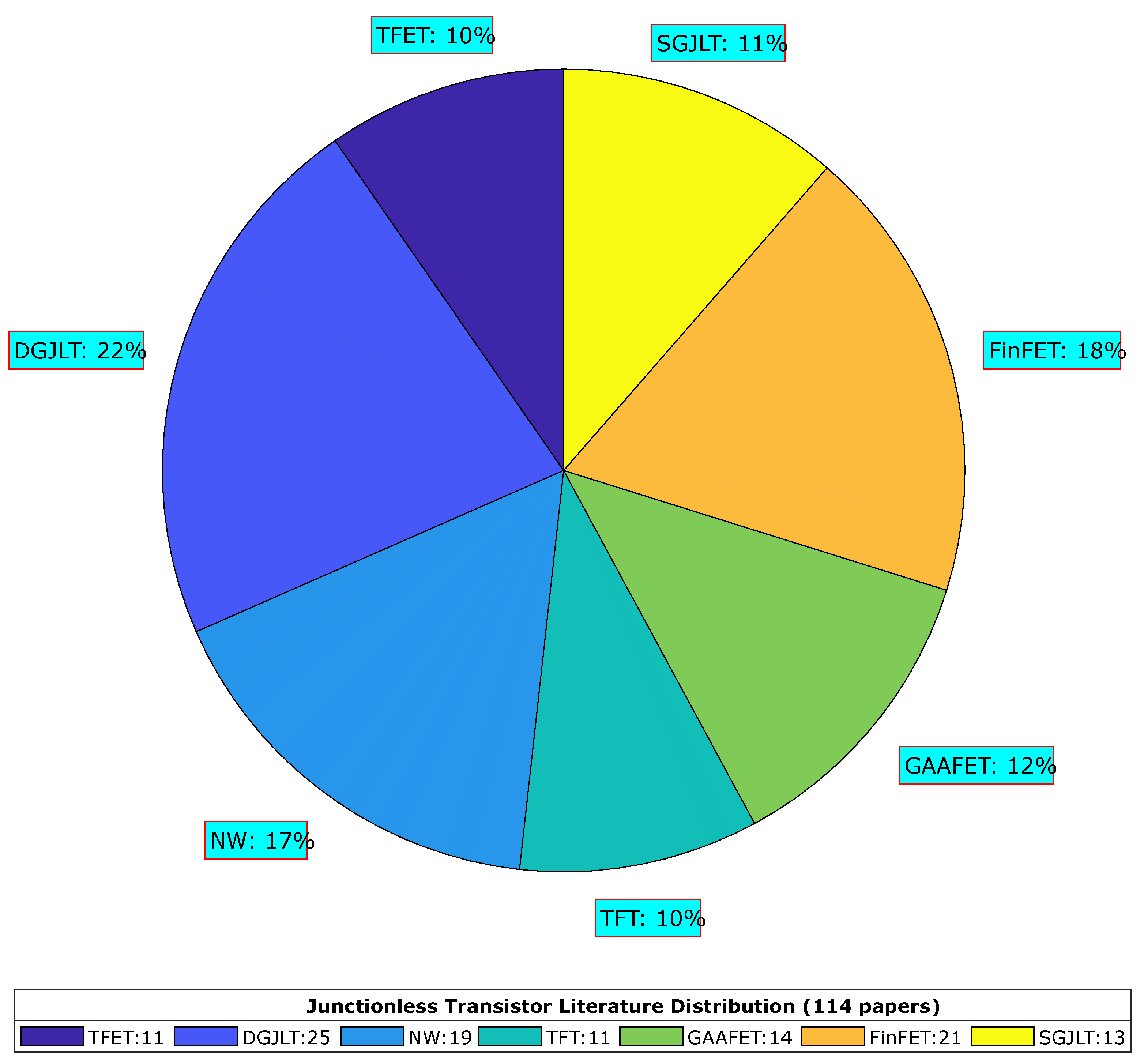
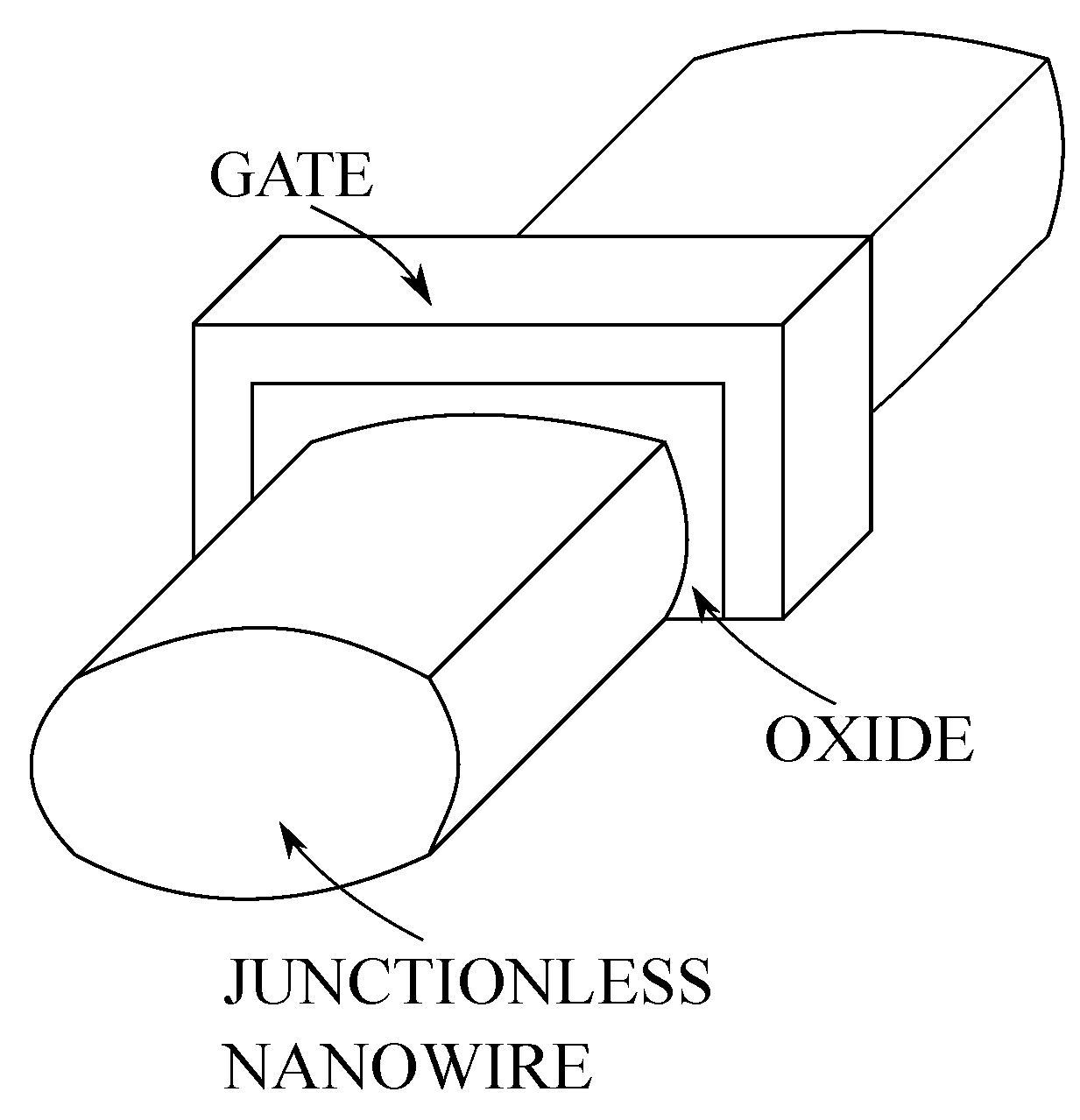

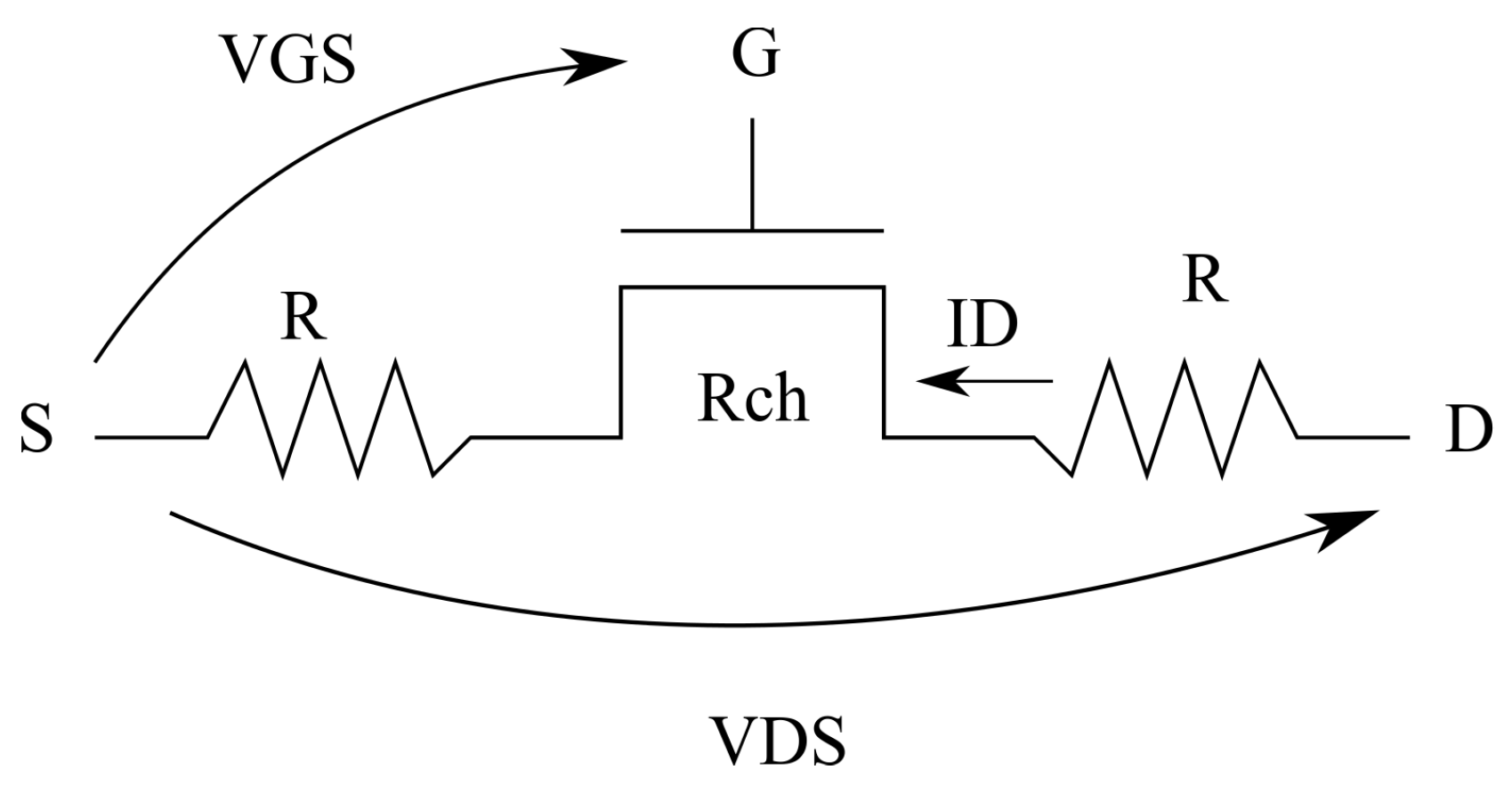

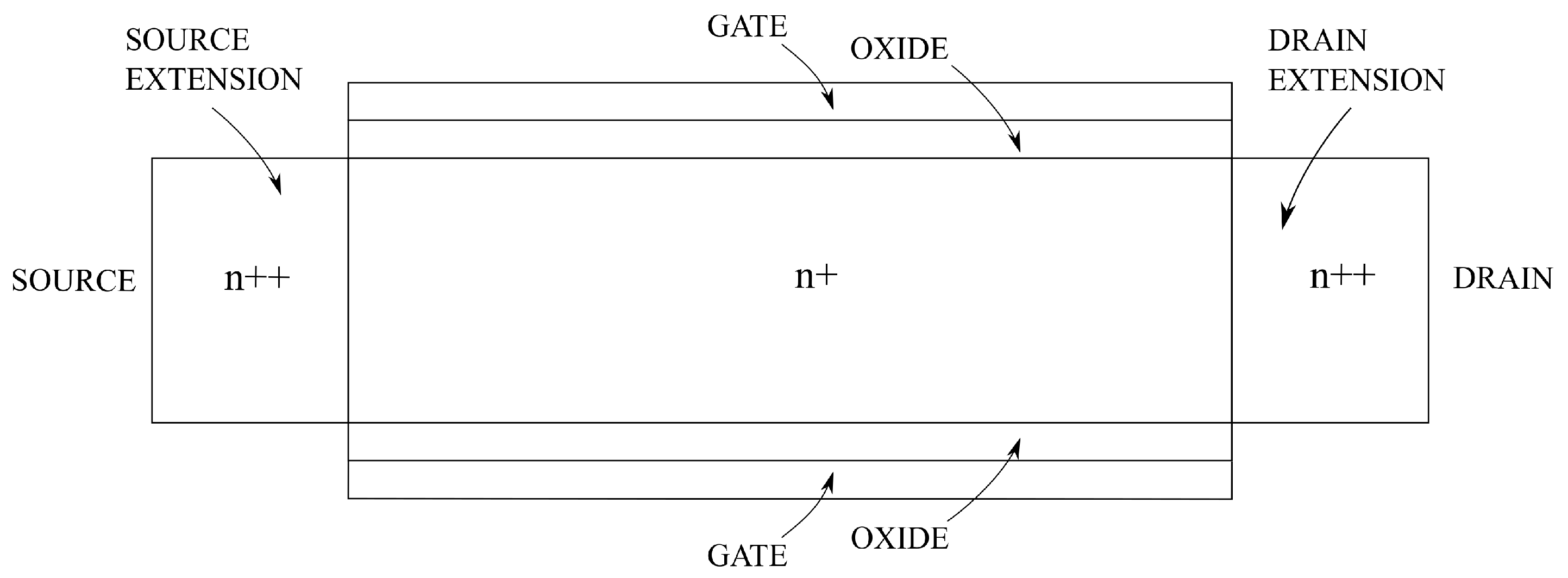
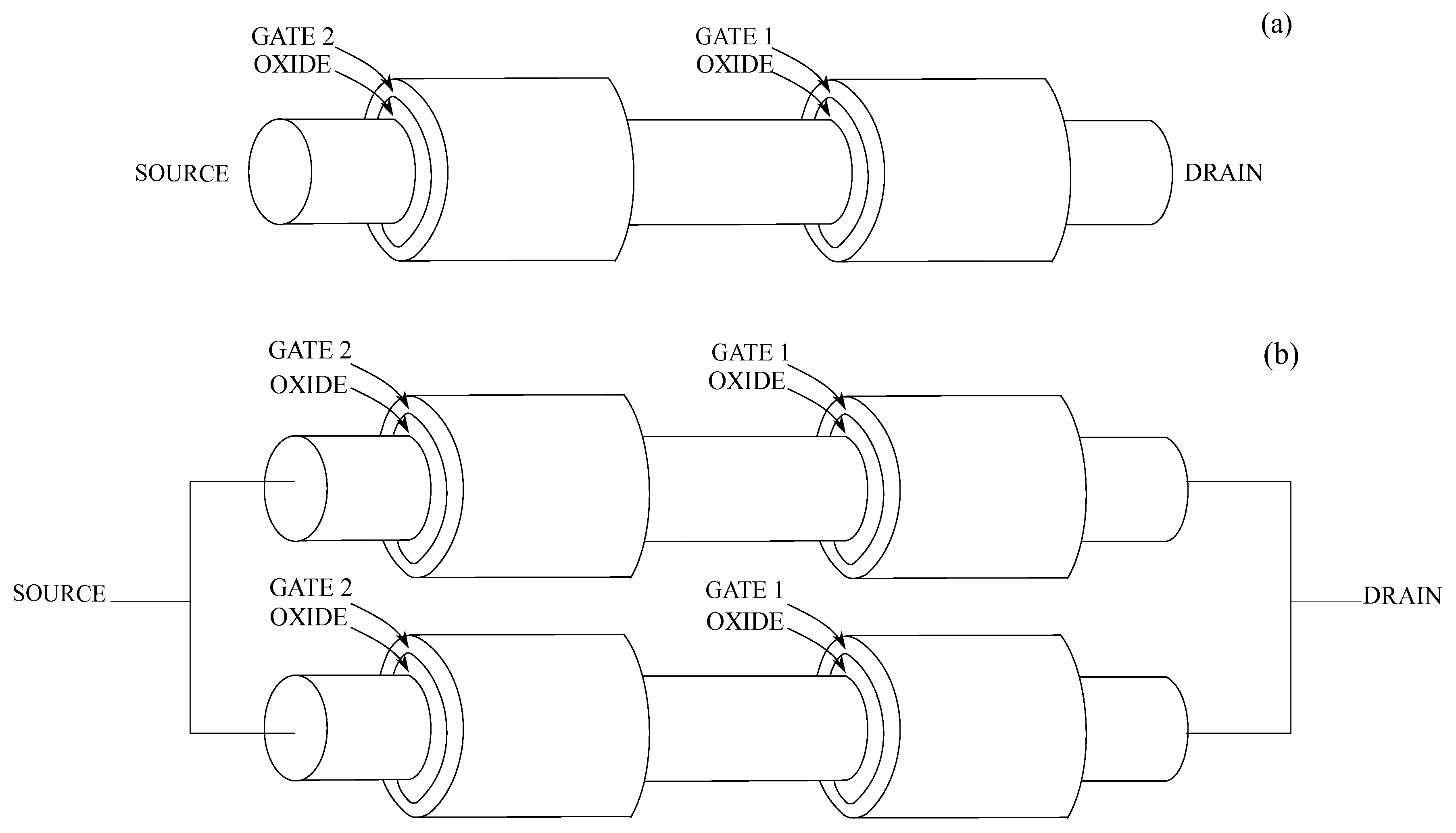

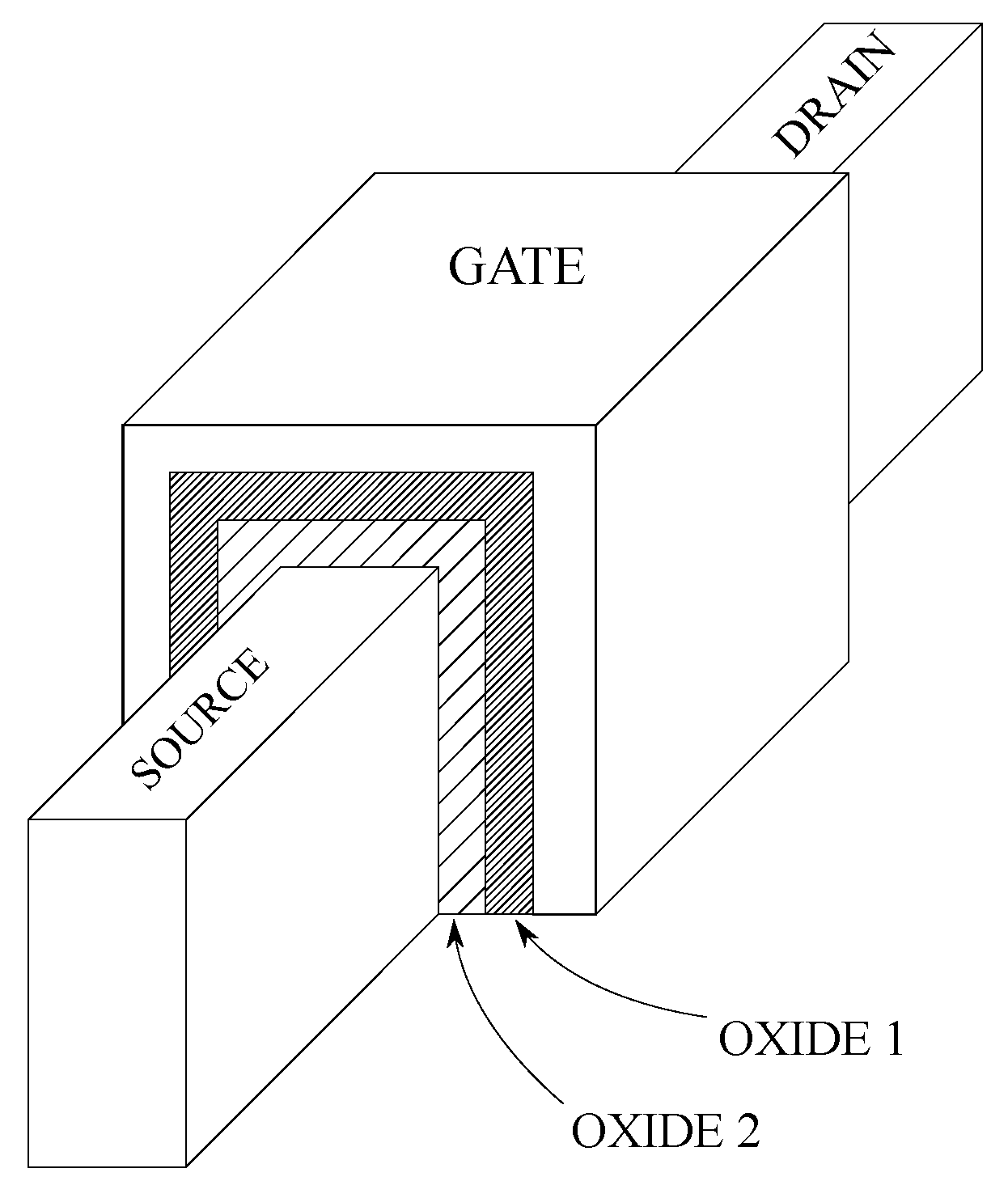
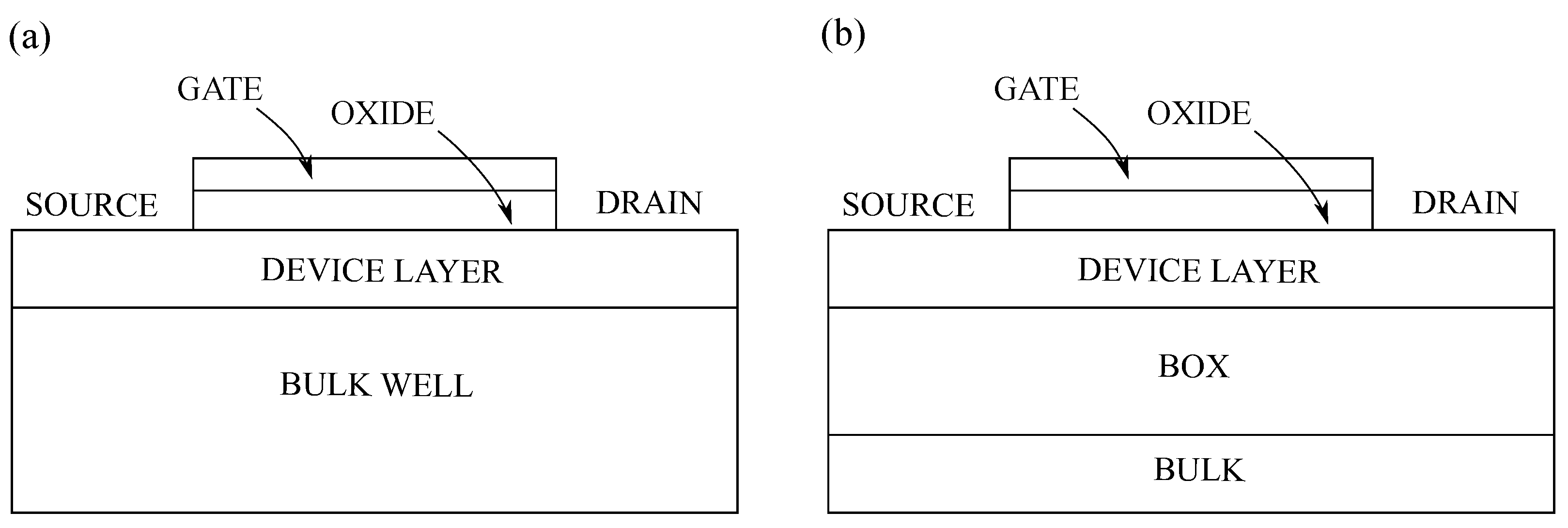
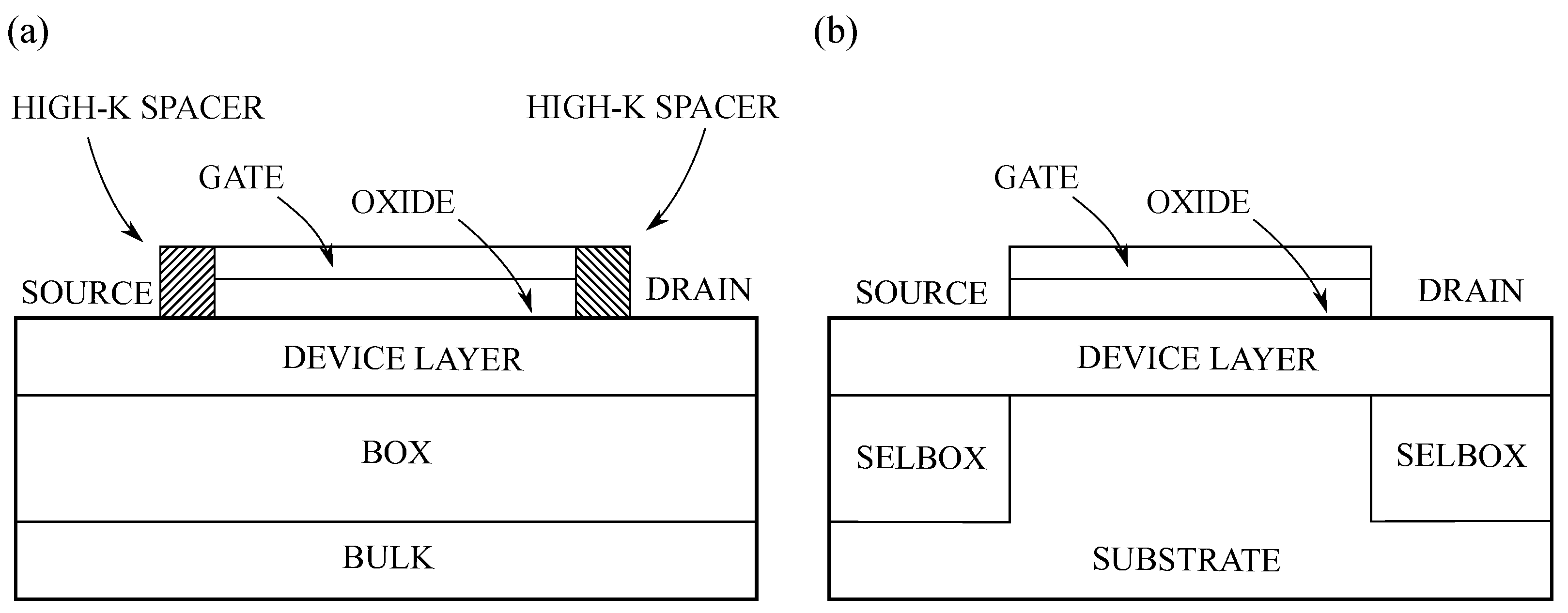
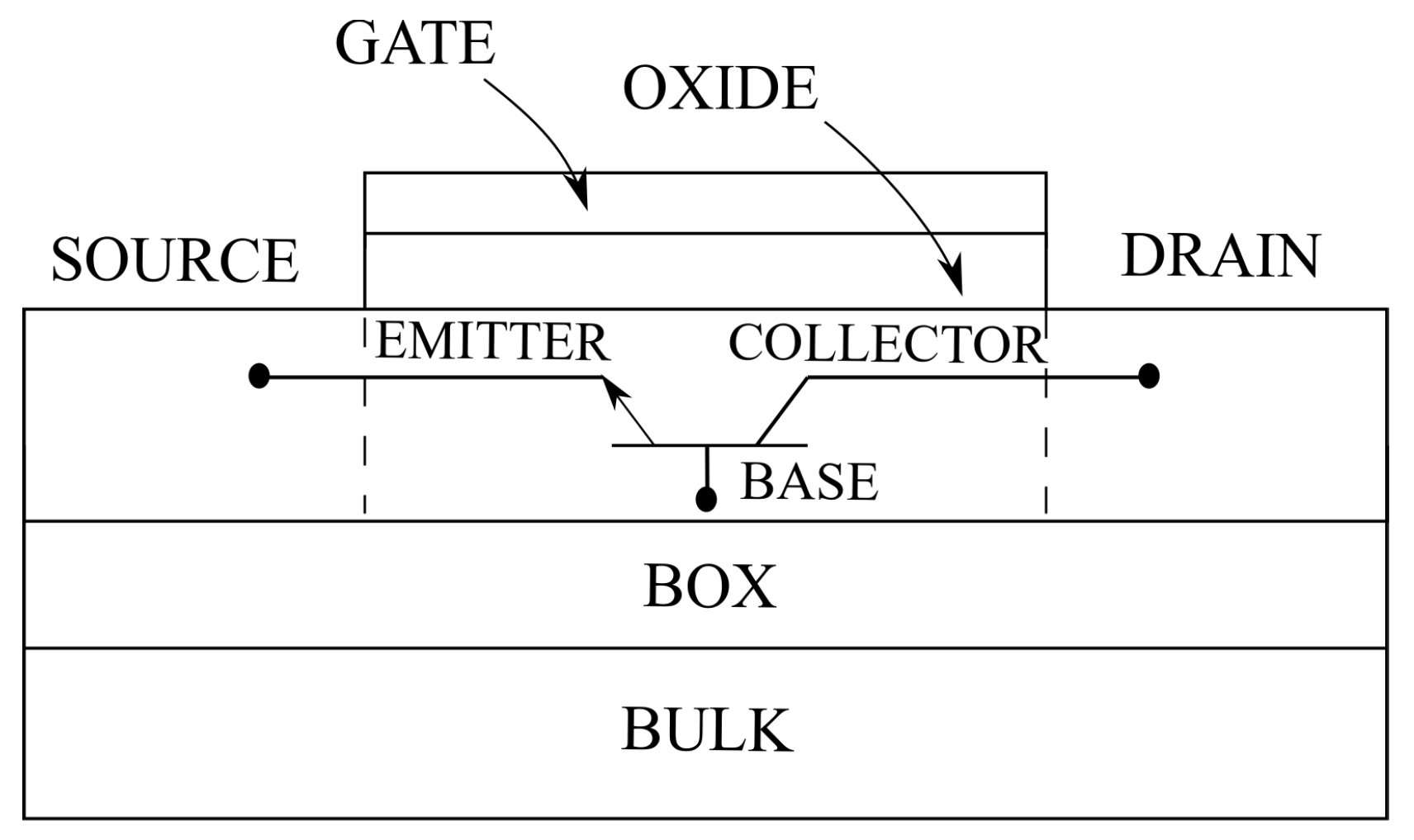
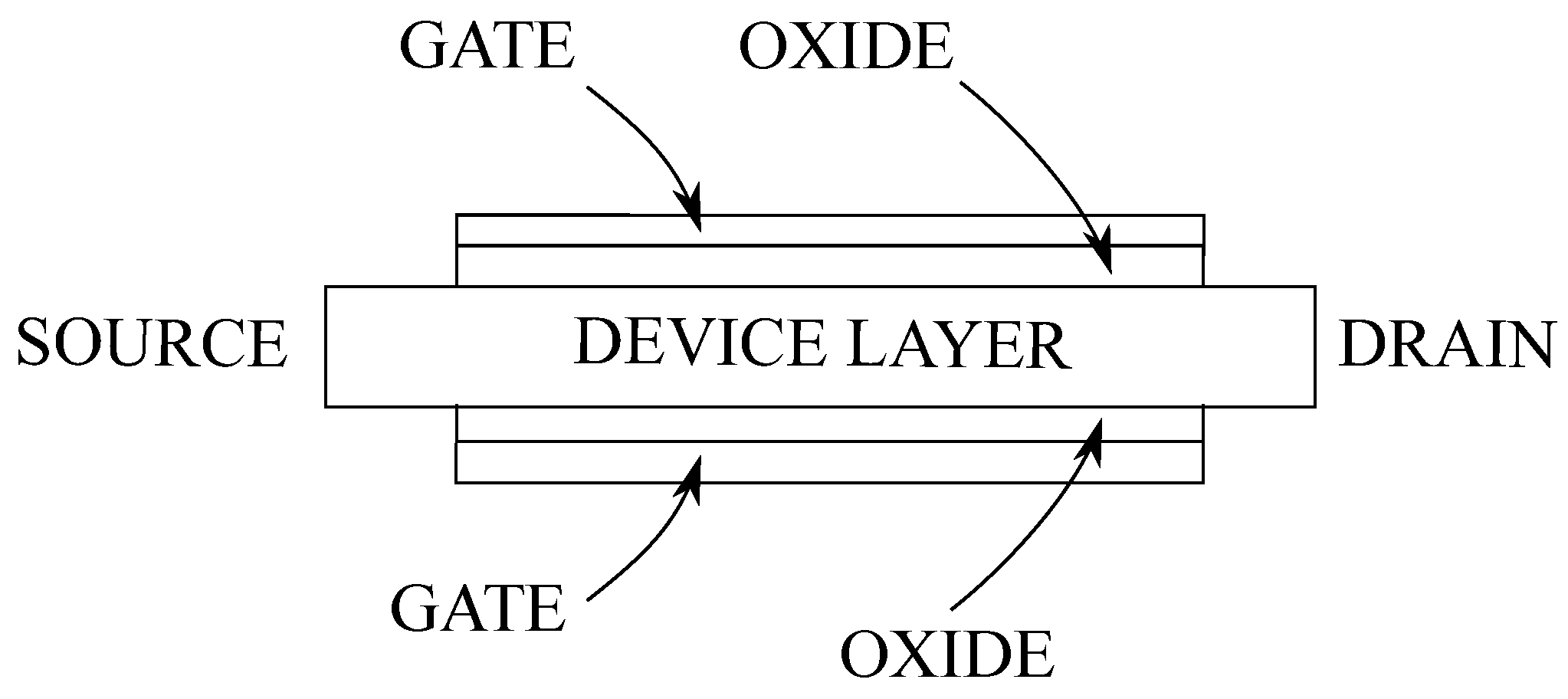
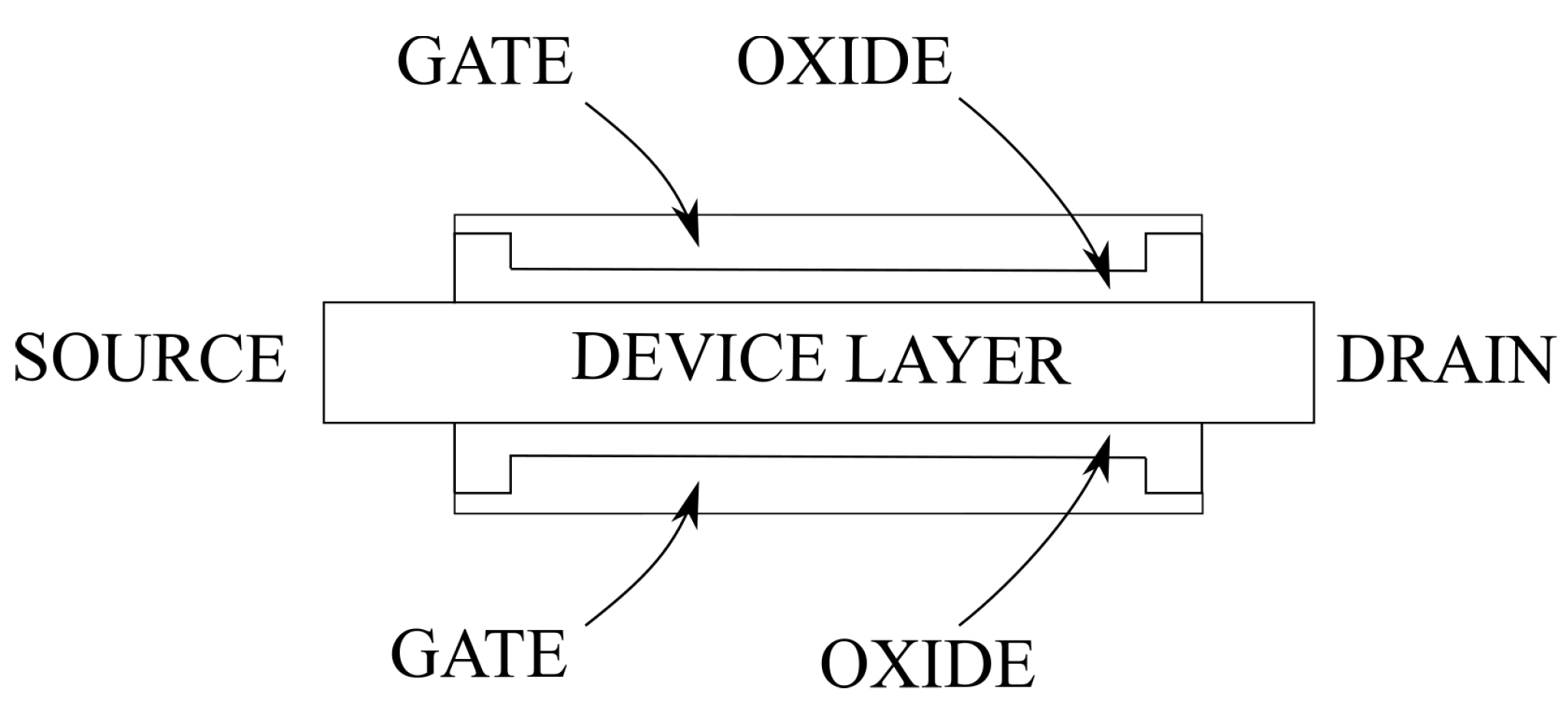
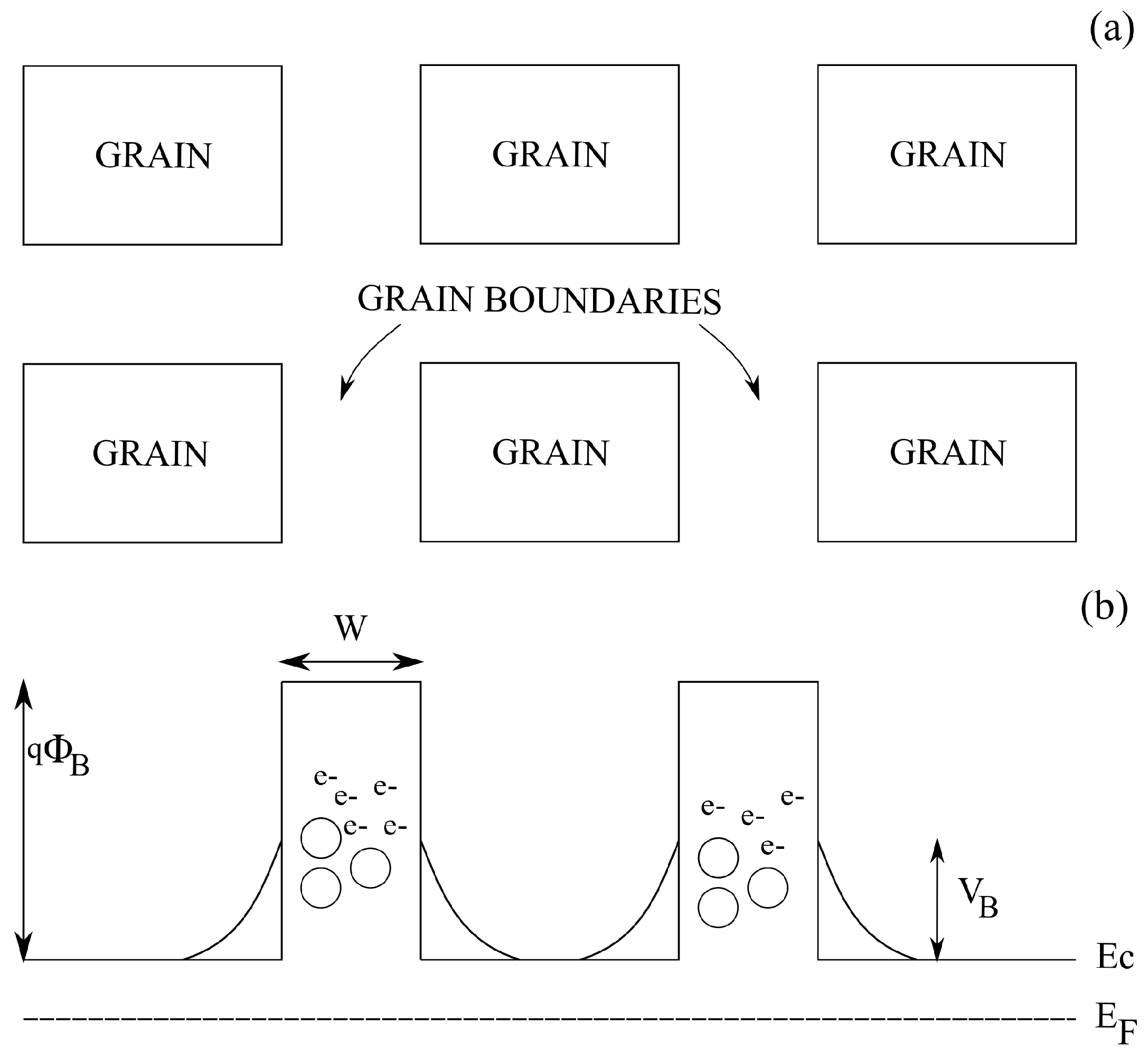
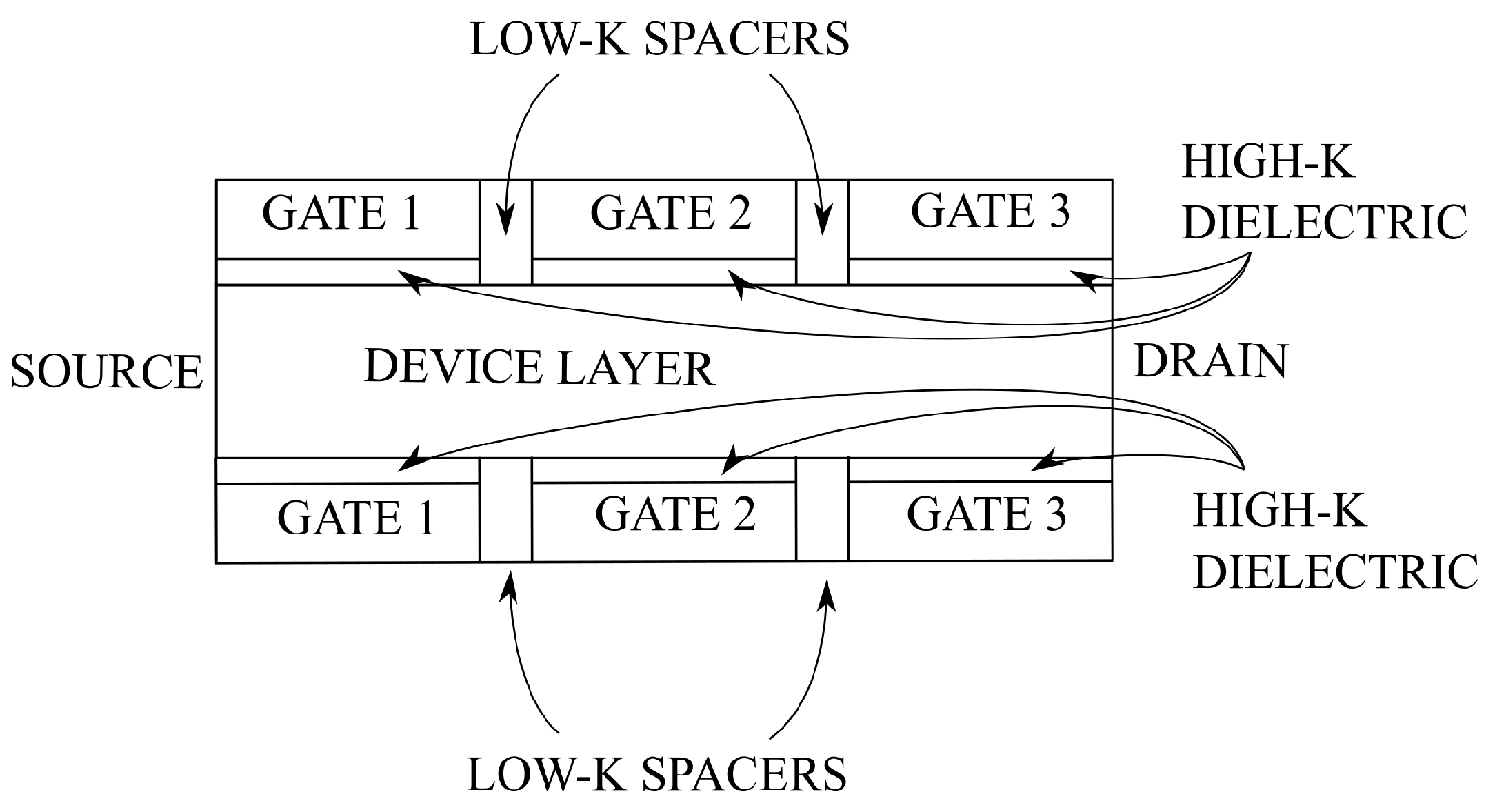

| GAAFET | (nm) | (nm) | (cm) | (mV/dec) | (mV/V) | Ref. | Year | |
|---|---|---|---|---|---|---|---|---|
| Si | - | 21 | × | 70 | 35 | > | [25] | 2013 |
| Si | 20 | 10 | 2 × | × | [35] | 2014 | ||
| Ge | 20 | 10 | 2 × | 5 × | [35] | 2014 | ||
| PolySi | 20 | 45 | - | 105 | 83 | 7 × | [33] | 2015 |
| Si (tensile) | - | 20 | - | 65 | - | > | [36] | 2016 |
| FinFET | (nm) | H (nm) | (nm) | (cm) | (mV/dec) | (mV/V) | Ref. | Year | |
|---|---|---|---|---|---|---|---|---|---|
| Bulk (, k = 22) | 15 | 10 | 1 | × | 1 × | [6] | 2013 | ||
| SOI (, k = 22) | 15 | 10 | 1 | × | - | [6] | 2013 | ||
| Bulk | 15 | 10 | 1 | × | - | - | × | [7] | 2014 |
| Bulk (, k = 22) | 15 | 10 | 1 | 1 × | - | [5] | 2017 | ||
| SOI (, k = 22) | 15 | 10 | 1 | 1 × | - | [5] | 2017 | ||
| SON (, k = 22) | 15 | 10 | 1 | 1 × | 1 × | [5] | 2017 | ||
| SOI (, k = ) | 5 | 6 | 1 | 1 × | 20 | - | [14] | 2017 | |
| SOI (, k = 40) | 5 | 6 | 1 | 1 × | - | [14] | 2017 | ||
| Single (, k = ) | 13 | 1 × | 23 | ∼ × | [16] | 2017 | |||
| Dual (k = ) | 13 | 1 × | 11 | ∼ × | [16] | 2017 | |||
| InGaAs | 60 | 28 | 1 × | 96 | 106 | 5 × | [23] | 2018 | |
| w/o HGO (k = ) | 14 | 5 | 5 × | 70 | 52 | 1 × | [8] | 2019 | |
| DHGO (k = 22) | 14 | 5 | 5 × | 64 | 20 | × | [8] | 2019 | |
| THGO (k = 9) | 14 | 5 | 5 × | 64 | 20 | × | [8] | 2019 | |
| QHGO (k = ) | 14 | 5 | 5 × | 64 | 20 | × | [8] | 2019 |
| Structure | (nm) | (nm) | (cm) | (nm) | (A/m) |
|---|---|---|---|---|---|
| Single Gate | 20 | 10 | uniform | 0 | |
| Double Gate | 20 | 10 | uniform | 0 | |
| Single Gate | 20 | 10 | non-uniform | 6 | |
| Double Gate | 20 | 10 | non-uniform | 6 |
| Thin Film | (nm) | (nm) | (cm) | (mV/dec) | (mV/V) | Ref. | Year | |
|---|---|---|---|---|---|---|---|---|
| Single Gate | 400 | 10 | ≥1 × | 240 | - | >1 × | [76] | 2011 |
| NW GAA | 1000 | 12 | - | 199 | - | × | [82] | 2011 |
| NW GAA (IM) | 1000 | 12 | - | 184 | - | - | [82] | 2011 |
| Single Gate | 400 | 9 | - | 309 | 161 | 8 × | [83] | 2012 |
| Single Gate (IM) | 400 | 50 | - | 326 | 277 | × | [83] | 2012 |
| NW GAA | 60 | 2 | 3 × | 61 | 6 | 1 × | [84] | 2013 |
| Single Gate | 1000 | 10 | - | 329 | - | × | [79] | 2014 |
| Double Gate | 1000 | 10 | - | 160 | - | × | [79] | 2014 |
| NW GAA | 200 | 8 × () | 43 | <0.4 | >1 × | [85] | 2017 |
| Tunnel FET | (nm) | (nm) | N (cm) | (mV/dec) | (mV/V) | Ref. | Year | |
|---|---|---|---|---|---|---|---|---|
| DG | 25 | 5 | 2 × | 24 | 38 | × | [95] | 2013 |
| DG (, k = 30) | 20 | 5 | 1 × | ∼87 | − | ∼3.5 × | [88] | 2013 |
| DG (, k = 25) | 20 | 5 | 1 × | ∼91 | − | ∼3 × | [88] | 2013 |
| DG (, k = 80) | 20 | 5 | 1 × | ∼70 | − | ∼6 × | [88] | 2013 |
| DG () | 20 | 5 | 1 × | ∼41 | − | ∼1 × | [90] | 2014 |
| DG | 20 | 5 | 1 × | ∼23 | − | ∼1 × | [92] | 2014 |
| DG | 20 | 5 | 1 × | 84 | − | 8 × | [89] | 2014 |
| DG () | 20 | 5 | 1 × | 26 | − | 2 × | [89] | 2014 |
| DG () | 20 | 5 | 1 × | 74 | − | 2 × | [89] | 2014 |
| DG () | 20 | 5 | 1 × | 32 | − | 8 × | [89] | 2014 |
| DG () | 20 | 5 | 1 × | 44 | − | 8 × | [89] | 2014 |
| DG () | 20 | 5 | 1 × | 16 | − | 2 × | [89] | 2014 |
| SG () | 20 | 10 | 1 × | 7 | 86 | ∼2 × | [96] | 2016 |
| DG () () | 20 | 5 | 1 × | − | ∼1 × | [94] | 2017 | |
| DG () () | 20 | 5 | 1 × | − | ∼1 × | [94] | 2017 | |
| DG () () | 20 | 5 | 1 × | − | ∼1 × | [94] | 2017 | |
| Dual-Material DG | 20 | 5 | 1 × | 60 | − | − | [97] | 2019 |
© 2020 by the authors. Licensee MDPI, Basel, Switzerland. This article is an open access article distributed under the terms and conditions of the Creative Commons Attribution (CC BY) license (http://creativecommons.org/licenses/by/4.0/).
Share and Cite
Nowbahari, A.; Roy, A.; Marchetti, L. Junctionless Transistors: State-of-the-Art. Electronics 2020, 9, 1174. https://doi.org/10.3390/electronics9071174
Nowbahari A, Roy A, Marchetti L. Junctionless Transistors: State-of-the-Art. Electronics. 2020; 9(7):1174. https://doi.org/10.3390/electronics9071174
Chicago/Turabian StyleNowbahari, Arian, Avisek Roy, and Luca Marchetti. 2020. "Junctionless Transistors: State-of-the-Art" Electronics 9, no. 7: 1174. https://doi.org/10.3390/electronics9071174
APA StyleNowbahari, A., Roy, A., & Marchetti, L. (2020). Junctionless Transistors: State-of-the-Art. Electronics, 9(7), 1174. https://doi.org/10.3390/electronics9071174







